Electrical tools are essential for various tasks, from wiring to circuit testing. Common tools include screwdrivers, pliers, wire strippers, and multimeters. A catalogue with names, pictures, and uses helps professionals and DIYers identify and organize these tools efficiently.
1.1 Importance of Electrical Tools in Modern Work
Electrical tools are indispensable in modern work, enabling efficient and precise task execution. They ensure safety, accuracy, and reliability in installations, maintenance, and repairs. From screwdrivers to multimeters, these tools empower professionals to handle complex electrical systems. Their versatility and durability make them essential for industries, ensuring productivity and compliance with safety standards. Proper tool usage is critical for avoiding hazards and delivering high-quality workmanship.
1.2 Overview of Common Electrical Tools
Common electrical tools include screwdrivers, pliers, wire strippers, and multimeters. These tools are vital for tasks like wiring, circuit testing, and insulation. A catalogue with names and pictures helps users identify and organize these tools efficiently. From basic hand tools to advanced power tools, they cater to various electrical needs, ensuring precise and safe work. Their availability in different sizes and types makes them indispensable for professionals and DIY enthusiasts alike in modern electrical work environments.
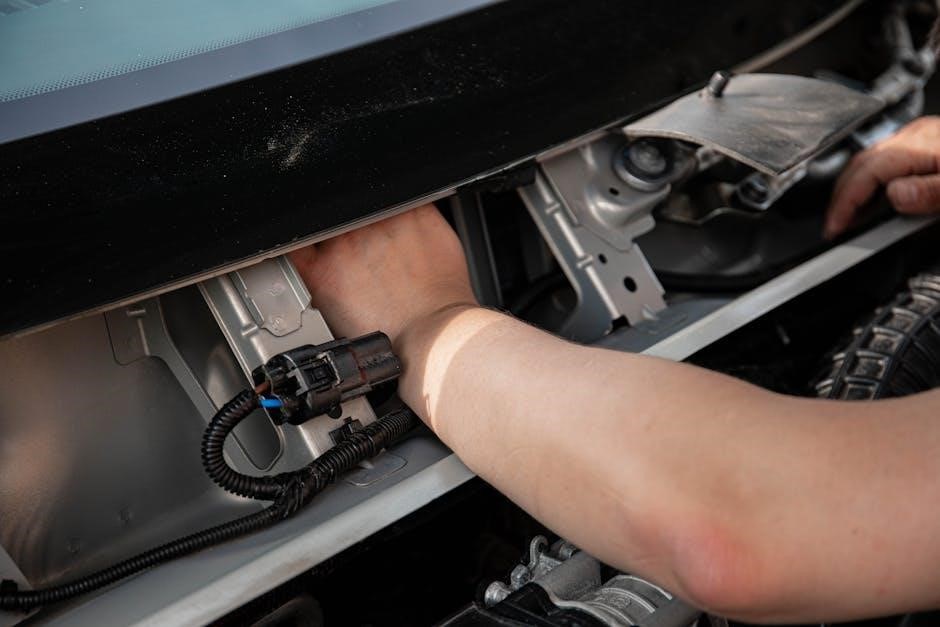
Hand Tools for Electrical Work
Hand tools like screwdrivers, pliers, and wire strippers are essential for electrical tasks. They ensure precise handling of wires and components, making them indispensable for safe and efficient work.
2.1 Pliers and Their Types
Pliers are versatile hand tools essential for gripping and bending objects. Common types include needle-nose pliers for reaching tight spaces, slip-joint pliers for general gripping, and locking pliers for secure clamping. Each type is designed for specific tasks, making them indispensable in electrical work for handling wires and small components safely and efficiently.
2.2 Screwdrivers: Flat, Philips, and Allen
Screwdrivers are fundamental tools for driving screws. Flat-head screwdrivers are used for slotted screws, while Philips-head screwdrivers handle cross-shaped screws, reducing cam-out. Allen wrench screwdrivers are designed for hexagonal recesses, often in bolts. Each type ensures proper torque and prevents damage, making them essential for electrical tasks requiring precision and reliability.
2.3 Wire Strippers and Their Uses
Wire strippers are essential for safely removing insulation from electrical wires. Available in manual and automatic designs, they precisely strip wires without damaging the conductor. Used for various gauges, they ensure clean connections for soldering, crimping, or splicing. Proper use prevents wire damage, making them indispensable for electrical installations, repairs, and DIY projects.
2.4 Tape Measure for Accurate Measurements
A tape measure is a versatile tool for accurate length, width, and height measurements. It features flexible, extendable tapes with clear markings, ensuring precision in various electrical tasks. Electricians rely on it for installing wiring, mounting devices, and measuring conduit sizes. Durable designs withstand workplace conditions, making it an essential addition to every electrician’s toolkit for consistent and reliable measurements.
2;5 Electrical Tape for Insulation

Electrical tape is a versatile tool for insulating wires and cables, preventing electrical shocks and short circuits. Made from durable vinyl, it offers weather and chemical resistance. Available in various colors, it helps in color-coding wires for easy identification. Commonly used for temporary repairs and securing connections, electrical tape is a must-have for electricians and DIYers. Its flexibility and adhesive properties ensure long-lasting protection, making it indispensable in both residential and industrial electrical tasks.

Power Tools for Electrical Applications
Power tools like drills, impact wrenches, and heat guns are essential for electrical tasks. They enhance efficiency in drilling, fastening, and melting materials, ensuring precise and durable results.
3.1 Drill Machines for Drilling Holes
Drill machines are versatile power tools used for creating precise holes in various materials. They are essential for installing fixtures, running wires, and mounting equipment. Available in corded and cordless models, they offer adjustable speeds for different materials. Safety features like insulated handles and secure grips prevent accidents. Proper maintenance ensures longevity and optimal performance. Their portability and power make them indispensable for both professionals and DIY enthusiasts in electrical tasks.
3.2 Impact Wrench for Tightening Bolts
An impact wrench is a powerful tool designed for tightening and loosening bolts and nuts. It delivers high torque, making it ideal for heavy-duty electrical tasks. Corded and cordless models offer versatility. Insulated handles enhance safety, preventing electric shock. Regular maintenance ensures optimal performance. This tool is indispensable for electricians working with large machinery and industrial equipment, providing efficiency and reliability in demanding environments. Its robust design and precision make it a must-have for professional and DIY projects alike.
3.3 Rotary Hammer for Heavy-Duty Tasks
A rotary hammer is a versatile power tool designed for heavy-duty applications like drilling, chiseling, and demolition. Available in SDS Plus and SDS Max types, it excels in masonry work. The tool combines rotational force with hammering action for efficient concrete drilling. Key features include adjustable speed, ergonomic handles, and dust protection. Ideal for electrical installations requiring anchor drilling, it ensures precise and powerful performance. Regular maintenance, like lubricating moving parts, enhances longevity and reliability in demanding projects.
3.4 Heat Gun for Shrinking and Melting
A heat gun is a versatile tool used for shrinking wires, melting adhesives, and soldering. It operates by emitting hot air at adjustable temperatures. Common applications include shrinking heat shrink tubing, drying surfaces, and softening materials. Safety precautions, such as avoiding direct contact with skin, are essential. Heat guns are indispensable in electrical work for tasks requiring precise temperature control. Their portability and variable heat settings make them ideal for both small and large-scale projects, ensuring efficient and safe operations. Regular maintenance ensures optimal performance and longevity.
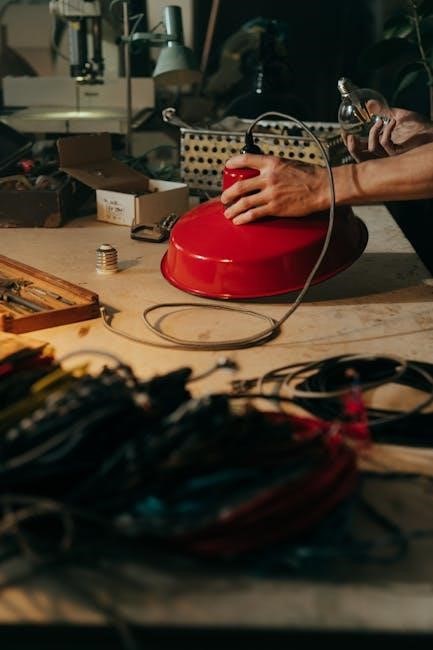
Measurement and Testing Tools
Essential for diagnosing electrical systems, these tools include multimeters, insulation testers, and circuit testers. They ensure safety and accuracy, measuring voltage, current, and resistance efficiently.
4.1 Multimeter for Voltage, Current, and Resistance
A multimeter is a versatile tool for measuring voltage, current, and resistance in electrical circuits. It helps diagnose issues, ensuring safety and efficiency. Digital models offer precise readings, while analog versions provide a classic interface. With various ranges and settings, multimeters are indispensable for electricians and technicians. They often include additional features like continuity testing and capacitance measurement, making them a comprehensive solution for troubleshooting electrical systems.
4.2 Insulation Tester for Safety Checks
An insulation tester ensures electrical systems are safe by verifying the integrity of insulation materials. It detects faults, preventing shocks or fires. Commonly used in high-voltage settings, these testers measure resistance levels. Features include multiple test voltages and clear displays. Regular use helps maintain compliance with safety standards, protecting both equipment and personnel from potential hazards. Insulation testers are crucial for routine maintenance and troubleshooting in industrial and domestic electrical environments.
4.3 Circuit Tester for Live Wires
A circuit tester is a vital tool for detecting live wires in electrical circuits. It ensures safety by identifying active voltage sources, preventing accidental shocks or electrocution. These testers often feature LED lights or sound alerts to indicate live wires. They are essential for diagnosing circuit issues and verifying de-energized systems before maintenance. Regular use promotes safe working practices, reducing risks for electricians and technicians. Circuit testers are a must-have for any electrical toolkit, ensuring reliable and secure operations.
4.4 Clamp Meter for Measuring Current
A clamp meter is a versatile tool for measuring electrical current, voltage, and resistance without breaking the circuit. It features a jaw-like clamp that wraps around wires, allowing safe and non-invasive measurements. Ideal for troubleshooting, it provides accurate readings for diagnosing electrical issues. Clamp meters are essential for ensuring systems operate within specifications. Their rugged design and ease of use make them indispensable for electricians, offering a reliable way to monitor and maintain electrical systems safely and efficiently.
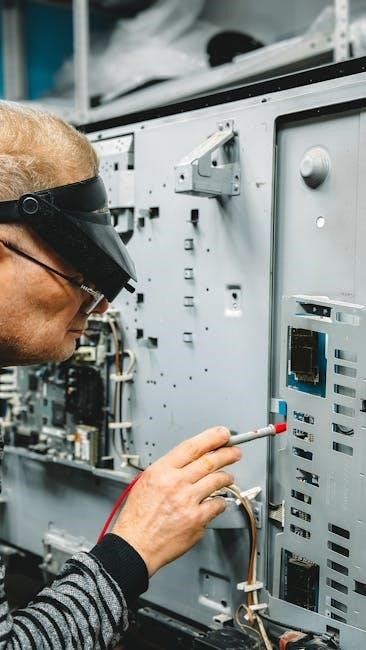
Safety Equipment for Electricians
Safety equipment for electricians includes insulated wrenches, safety gloves, goggles, and fire-resistant clothing. These tools protect against electrical shocks, arcs, and physical hazards, ensuring safe working conditions.
5.1 Insulated Wrenches and Pliers
Insulated wrenches and pliers are crucial for electricians to safely work with live circuits. Made from high-quality tool steel, they prevent electrical shocks and ensure secure handling. Designed to withstand high voltages, these tools feature ergonomic handles for comfort and grip. Regular inspection is essential to maintain their insulation integrity and ensure reliability during critical tasks. They are indispensable for professionals working with electrical and power installations, providing both safety and precision.
5.2 Safety Gloves for Protection
Safety gloves are essential for protecting hands from electrical shocks and physical injuries. Made from durable materials like rubber or latex, they provide insulation and grip. Electricians use high-voltage gloves for live wire work, while general-purpose gloves suffice for lower risks. Proper fit and regular inspection ensure effectiveness. They are a critical component in safeguarding electricians during installations, repairs, and maintenance tasks, ensuring both safety and dexterity.
5.3 Safety Goggles for Eye Protection
Safety goggles are crucial for protecting eyes from debris, sparks, and electrical arcs. They are typically made of impact-resistant materials like polycarbonate or acetate. Anti-fog and anti-scratch coatings enhance visibility and durability. Electricians use them when drilling, cutting, or working with live circuits. Proper fit ensures comfort and effectiveness. Regular cleaning and storage maintain their protective qualities. Safety goggles are a non-negotiable part of an electrician’s PPE, safeguarding vision in hazardous work environments.
5.4 Fire-Resistant Clothing
Fire-resistant clothing is designed to protect electricians from thermal hazards like electrical arcs and flashes. Made from flame-retardant materials, it minimizes burn risks during high-voltage work. These garments often feature multi-layered insulation and breathable fabrics for comfort. They are essential for workers in high-risk environments, ensuring safety and compliance with industry standards. Proper fitting and regular maintenance are crucial to maintain their protective properties, making them a critical component of PPE for electricians.
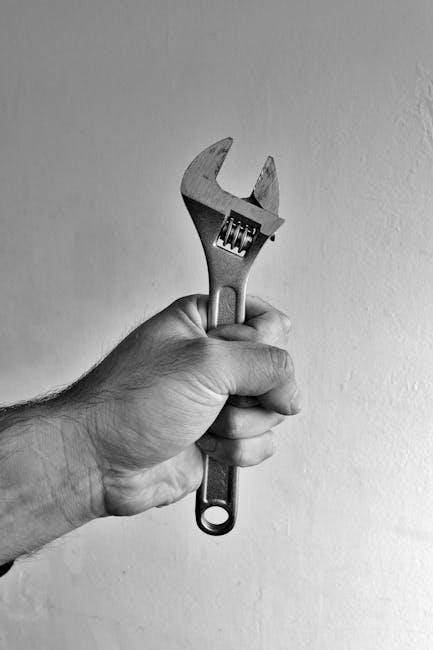
Fastening and Connecting Tools
Fastening and connecting tools are essential for securing wires and making reliable electrical connections. Key tools include cable ties, crimping tools, soldering irons, and wire nuts.
6.1 Cable Ties for Securing Wires
Cable ties are versatile tools for organizing and securing wires in electrical systems. They come in various sizes and materials, ensuring durability and reliability. Easy to install, they prevent wire tangling and damage, enhancing safety. Available in options like nylon or stainless steel, cable ties are indispensable for neat and efficient wiring setups in both residential and industrial applications.
6.2 Crimping Tools for Wire Connections
Crimping tools are essential for creating secure wire connections. They compress connectors onto wires, ensuring reliable electrical contacts. Available in handheld or hydraulic models, they cater to various wire sizes and types. Proper crimping prevents loose connections, which can cause short circuits or signal loss. Regularly used in both residential and industrial settings, crimping tools are a must-have for electricians to maintain safety and efficiency in wiring systems.
6.3 Soldering Iron and Station
A soldering iron and station are vital for precision soldering in electrical tasks. The iron heats solder to create strong, conductive joints between wires and components. Stations often include temperature control, ensuring optimal melting without damage. They are widely used in electronics repair, circuit board assembly, and wiring. Regular maintenance, like cleaning the tip, extends tool life and performance. Electricians rely on these tools for durable and reliable electrical connections in various projects.
6.4 Wire Nuts and Connectors
Wire nuts and connectors are essential for securing wires in electrical systems. They provide a safe, durable connection, preventing wires from coming loose. These connectors are insulated to protect against short circuits and are easy to install without special tools. Available in various sizes, they suit different wire gauges and applications. Wire nuts and connectors are versatile, ensuring reliable and long-lasting electrical connections in both residential and industrial settings, making them a fundamental component in any electrician’s toolkit.
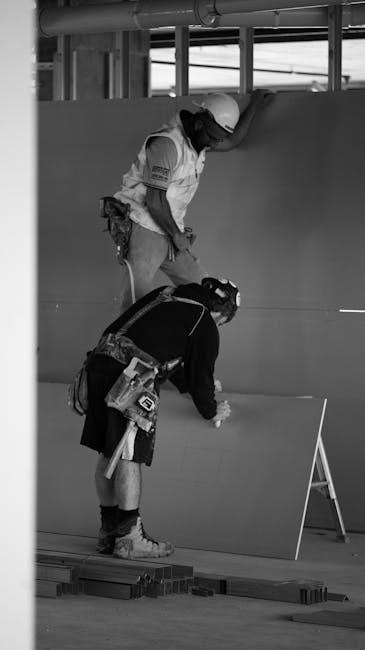
Miscellaneous Electrical Tools
Miscellaneous tools include fish tapes, levels, tool pouches, and side cutters. These tools assist in wire pulling, alignment, carrying essentials, and trimming wires efficiently in various tasks.
7.1 Fish Tape for Pulling Wires
Fish tape is a flexible, coiled metal tool used to pull wires through conduit or tight spaces. It features a hook or loop at the end to attach wires securely. Available in various lengths, fish tape is essential for electricians to navigate complex wiring systems efficiently. Proper use ensures safe and effective wire installation without damaging the surrounding structure or insulation. It is a must-have tool for both residential and industrial electrical projects.
7.2 Level for Straight Alignment
A level ensures precise alignment of electrical components and structures. It features a bubble vial that indicates when surfaces are perfectly horizontal or vertical. Torpedo and carpenter levels are common types used in electrical work. Ensuring straight alignment prevents installation errors and enhances safety. Regular calibration is necessary for accuracy. Its compact design makes it easy to carry in a tool pouch, making it indispensable for electricians working on installations, repairs, and renovations.
7.3 Tool Pouch for Carrying Essentials
A tool pouch is a versatile storage solution for electricians to carry essential tools like screwdrivers, pliers, and wire strippers. Made from durable materials, it keeps tools organized and accessible. Adjustable compartments and belt loops enhance portability, allowing professionals to work efficiently on-site. A well-structured pouch prevents tool misplacement and saves time during tasks. It’s a must-have for maintaining order and ensuring all necessary items are within easy reach, optimizing workflow and productivity in electrical projects and repairs.
7.4 Side Cutters for Trimming Wires
Side cutters are essential for trimming and cutting wires in electrical work. They feature high-carbon steel blades for durability and precision. Insulated handles ensure safe use near live circuits. Available in various sizes, they suit different wire gauges. Regular maintenance, like sharpening blades, ensures optimal performance. Used in residential and industrial settings, side cutters are indispensable for clean, accurate cuts. Proper usage with safety goggles is recommended to prevent injuries from flying wire fragments, ensuring efficient and safe electrical tasks. Always choose cutters suitable for the wire type to avoid damage.
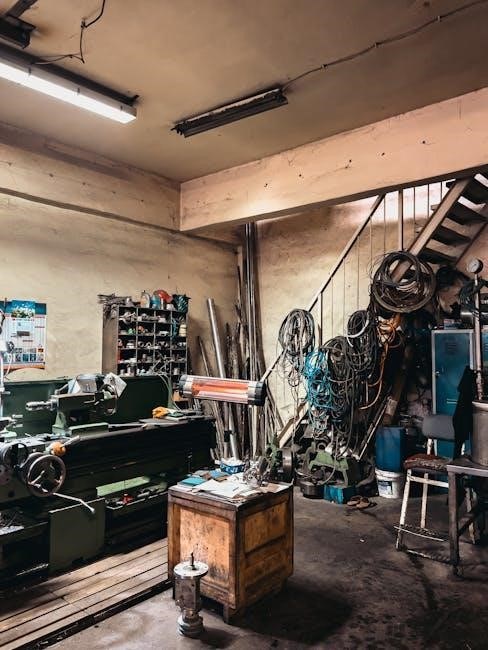
How to Create an Electrical Tools PDF Catalogue
Create a catalogue by listing tools with names, pictures, and descriptions. Organize them by category, such as hand tools or power tools, for easy reference. Include order numbers and symbols for clarity, ensuring each tool’s purpose and usage are clearly explained to aid professionals and DIYers in selection and application. This structured approach enhances accessibility and usability for users.
8.1 Listing Tools with Names and Pictures
Begin by listing each tool with its name and a high-quality image. Include screwdrivers, pliers, wire strippers, and multimeters. Add order numbers and symbols for clarity. Organize alphabetically or by category, ensuring each entry is visually distinct. This helps users quickly identify tools, making the catalogue user-friendly and practical for professionals and DIYers alike. The inclusion of pictures enhances understanding, while names and details ensure accurate tool selection and application.
8.2 Organizing Tools by Category
Organize tools into logical categories such as hand tools, power tools, and measurement devices. Group screwdrivers, pliers, and wrenches under hand tools. Power tools like drills and impact wrenches form another section. Measurement tools, including multimeters and insulation testers, should be categorized separately. This structure ensures easy navigation, allowing users to locate tools quickly. Clear headings and subheadings enhance usability, making the catalogue a valuable resource for electricians and professionals needing quick access to specific tools.

8.3 Adding Descriptions and Uses
Including detailed descriptions and uses for each tool enhances the catalogue’s functionality; For example, describe how wire strippers remove insulation or multimeters measure voltage. This helps users understand tool applications and select the right one for their tasks. Clear explanations improve usability, ensuring the catalogue serves as both a reference and learning resource for professionals and beginners alike. Accurate descriptions also prevent misuse, promoting safety and efficiency in electrical work.
Electrical tools are vital for safe and efficient work. Proper usage ensures safety, prevents equipment damage, and enhances productivity, making them indispensable in modern electrical tasks.
9.1 Summary of Key Electrical Tools
Key electrical tools include screwdrivers, pliers, wire strippers, and multimeters for measuring voltage and current. Insulation testers ensure safety, while cable ties organize wires neatly. These tools are indispensable for electrical tasks, enabling efficient and safe work. Proper selection and usage are crucial for achieving desired outcomes in installations, repairs, and maintenance. A well-organized catalogue with names and pictures helps professionals and DIYers identify and use these tools effectively, ensuring productivity and safety.
9.2 Importance of Proper Tool Usage
Proper tool usage ensures safety, efficiency, and high-quality workmanship. Using tools as intended prevents accidents and extends their lifespan. Misuse can lead to damage, injuries, or faulty electrical systems. Correct techniques and adherence to safety guidelines are crucial for reliable outcomes. This practice also ensures compliance with industry standards, protecting both the user and the electrical infrastructure. Proper tool usage is fundamental for maintaining professionalism and achieving consistent results in electrical tasks.
